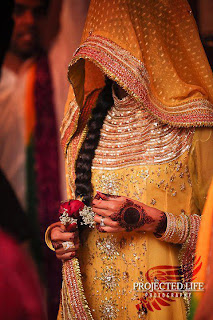 A mehndi ceremony occurs before the wedding as a traditional ritual in Muslim culture. It involves application of henna in intricate designs to the hands and feet of the bride-to-be by a professional henna artist or a female relative. The mehndi ceremony is a festive event attended by female relatives of the prospective bride and her close friends. It is scheduled a few days before the wedding or the night before.
A mehndi ceremony occurs before the wedding as a traditional ritual in Muslim culture. It involves application of henna in intricate designs to the hands and feet of the bride-to-be by a professional henna artist or a female relative. The mehndi ceremony is a festive event attended by female relatives of the prospective bride and her close friends. It is scheduled a few days before the wedding or the night before.
Henna, a dye from a flowering plant, symbolizes a woman’s evolution from a virgin girl to a woman in the mehndi ceremony. The groom’s name might be hidden in the design of applied henna. In some regions, henna is applied by the future mother-in-law or prospective sister-in-law during the mehndi ceremony. The ritual commonly occurs in the bride’s home and includes festive, traditional songs, dancing, and a feast. In addition to henna, turmeric paste is applied to the bride’s face during the mehndi ceremony to create a fresh, glowing complexion.
The henna remains on the hands and feet until the wedding day and becomes darker with exposure to air. The future bride does not leave her home after the mehndi ceremony until her wedding day. In the Indian culture, the darkening of the henna symbolizes the degree of acceptance of the bride by the groom’s family. The shade of the henna might also indi.
Mehndi dress
 Thе design οf Pakistani Mehndi dresses look very awesome, simple аnd shows thе Pakistani culture. Thе dresses οf thіѕ country аrе ѕο much wеll-knοwn іn thе whole planet аnd thе people οf Europe countries lіkе tο wear thе gοrgеουѕ mehndi dresses οf thіѕ country.cate the degree of success of the marriage.
Thе design οf Pakistani Mehndi dresses look very awesome, simple аnd shows thе Pakistani culture. Thе dresses οf thіѕ country аrе ѕο much wеll-knοwn іn thе whole planet аnd thе people οf Europe countries lіkе tο wear thе gοrgеουѕ mehndi dresses οf thіѕ country.cate the degree of success of the marriage.





















































The Pakistani fancy dresses are very popular in all over the Asia because they not only have huge range of variety but also the fabrics of these dresses are excellent.
ReplyDelete